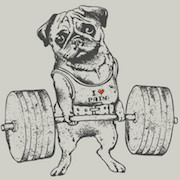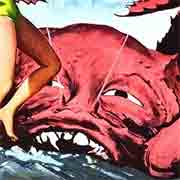|
Ravenfood posted:I do, constantly, because fencing is so far from its roots that its essentially divorced from them and is its own entity at this point. That's why it is a sport! Like, I roll my eyes at the HEMA people who try to tell me that I'm not doing real swordfighting because its so inherently obvious that I'm not doing real swordfighting that even having to say it is stupid. Why you've decided that your own weird definition of fencing is exclusionary and essentially "swordfighting", I'm not sure, but that's really not the definition most people would use. If you said you were a fencer, I'd probably ask which weapon and not think longsword, but I'm not going to say that longsword isn't a real sport so they can't be fencers. And most people probably don't think "longsword" when they hear "fencer" either. Because both wikipedia and Myrian-Webster (like, sure I know neither are definitive, but they are good for defining colloquial terms) for the entry for "fencing" describe "a sport in which two competitors fight using 'Rapier-style' swords, winning points by making contact with their opponent" and "the art or practice of attack and defense with the foil, épée, or saber". So yeah, that's why its so weird to have people tell me that I'm not doing real swordfighting. I'm not, because I am fencing. I never said anything about "sword fighting". I'm sorry so many HEMA people have tried to make that argument against you and sport fencing. In my eyes the art of fencing is the art of defending yourself with a weapon (not necessarily a sword) against someone else with a weapon. Hit and don't get hit. Realism and intent play a part in that, which is why I'm not saying "sport fencing is definitely not at all fencing". I'm saying sport fencing is its own distinct entity that exists perhaps alongside fencing. There's fencing, and there's sport fencing.
|
|
|
|

|
| # ? Apr 25, 2024 16:20 |
|
Siivola posted:I'm on a hot take roll today, so here's one for you guys: The "reality" we glorify in HEMA is entirely invented based on fragmented scholarship, pop history and movies. I mean, when kit up for freeplay, I have no loving clue what sort of role I'm supposed to play. Am I getting jumped in a back alley? Am I trying to take this guy prisoner, or vice versa? Is this guy just being a huge poo poo and honor demands I stab him in the face? Isn't that kind of important when you consider what you're supposed to be doing?
|
|
|
|
Verisimilidude posted:I never said anything about "sword fighting". I'm sorry so many HEMA people have tried to make that argument against you and sport fencing. Your definition is either so broad as to include Olympic fencing and sport fencing as "fencing", or you're making assumptions about other words, or you haven't defined it enough. "Weapon" for instance. Olypmpic blades certainly aren't weapons, because I'm not trying to hurt someone with them, nor are they designed for it, though I could. Which means if I and another person decided to take epees and try to actually kill/hurt each other with them, we'd be fencing I guess? Using feders, similarly, probably mean that you're not "fencing", because they are not designed to injure. Guns are, but I don't think you're trying to say that two people shooting each other are "fencing," even though they are both defending themselves with weapons, trying to hit the other, and trying not to get hit. Two people smashing each other with clubs is fencing? Are fists "weapons?" Intent "plays a part", but what is it when one person trying to kill the other, the other person trying to count coup before running? What if one person is trying to kill the other, and the second person is desperately trying not to hit their opponent? Fencing or not? Could you describe a time you have "fenced" under your definition? Can we justdescribe your personal definition of fencing as "artisanal fencing" from here on out, maybe? edit: HEY GAL posted:we may not fight like they fought, but what's preventing you from training like they trained? that's what hema is, in my opinion Ravenfood fucked around with this message at 16:53 on Aug 27, 2016 |
|
|
|
HEY GAL posted:we may not fight like they fought, but what's preventing you from training like they trained? that's what hema is, in my opinion Like, why are these people fighting with swords if they do not have a single beef between them? I get it's totally a training culture problem, but it's not entirely unrelated to this idea that all combat with swords is mortal and you should never take any risks ever.
|
|
|
|
^ What system are you training?Ravenfood posted:You've got a weird chip on your shoulder about this, but if it makes you feel better, I'll go back and clarify when I'm responding to you, KyloWinter, specifically, and when I'm responding to Matt Easton said in the video that you, KyloWinter, linked. Maybe because I didn't link it. barkbell fucked around with this message at 17:08 on Aug 27, 2016 |
|
|
|
KyloWinter posted:Maybe because I didn't link it.
|
|
|
|
Verisimilidude posted:In my eyes the art of fencing is the art of defending yourself with a weapon (not necessarily a sword) against someone else with a weapon. Verisimilidude posted:Hit and don't get hit. Realism and intent play a part in that If you want realism, go to the phillipines and start selling drugs. Someone will propably show you a realistic application of macheties or something. Siivola posted:I'm on a hot take roll today, so here's one for you guys: The "reality" we glorify in HEMA is entirely invented based on fragmented scholarship, pop history and movies. Siivola posted:Haha no, it's just ~the duel~. The same duel I'd fight with a sidesword, sabre or one of those fabulous dueling shields. Whoever doesn't get hit wins. HEY GAL posted:we may not fight like they fought, but what's preventing you from training like they trained? that's what hema is, in my opinion Nektu fucked around with this message at 17:23 on Aug 27, 2016 |
|
|
|
Siivola posted:I'm on a hot take roll today, so here's one for you guys: The "reality" we glorify in HEMA is entirely invented based on fragmented scholarship, pop history and movies. I mean, when kit up for freeplay, I have no loving clue what sort of role I'm supposed to play. Am I getting jumped in a back alley? Am I trying to take this guy prisoner, or vice versa? Is this guy just being a huge poo poo and honor demands I stab him in the face? Isn't that kind of important when you consider what you're supposed to be doing? I think a lot of fechtbucher appear to have been written with judicial duels in mind, as opposed to teh mean streetz of the 16th century, so I don't see a huge problem here with taking that sort of "final destination, no items" duel as a scenario to prepare for. But then there's stuff like the Montante manuals aimed at bodyguard duty, or dagger stuff that is more self defense oriented, so I do get your point that there's a bunch of other potential contexts, and could take a second or two to think about what our context is before jumping right into training.
|
|
|
|
Nektu posted:Hey, thats totally historical. The whole feder fencing is just historical sports fencing introduced by some german guy (Joachim Meyer) who was pissed off that the glorious german longsword became outdated because everybody wanted to use those darn foreign rapiers for serious work (even he suggested to use rapiers for self defense). On an unrelated note, here's a neat video for all you sabreists: https://www.youtube.com/watch?v=ydQ19fbXzFU (Will probably make more sense if you also read this article.)
|
|
|
|
All of this talk about the histories, what we know and don't, and how things evolved? Really cool! Watching the longsworders at my club? Really cool! Would I be sport fencing if it was more like classical fencing? Not a chance! (But as annoying as this discussion has been at times, it's still been a million times better than anything on fencing.net)
|
|
|
|
i'm too sober to fight like they fought anyway
|
|
|
|
KyloWinter posted:^ What system are you training? Oh and I'm gonna do foil too. Why do I start so many things at once why. 
|
|
|
|
Siivola posted:According to Wiktenauer, instead of revitalizing longsword Meyer was trying to adapt the old sources on the sword to the legislation and the fencing guild rules. Siivola posted:I think (but can't confirm) feders predate Meyer quite a bit, as does fencing with them for sport.
|
|
|
|
I had to go back and make sure that I didn't imagine feders predating Meÿer. The fightbook illustrations are generally kinda bad, but Mair's manual from 1540 shows longswords that are clearly feders. Meÿer was born in 1538. As for the fencing style, some form of sportified Liechtenauer is possible. The Marxbrüder had been around since the 15th century, many authors in the tradition are connected to them, and they were still active in Meÿer's time. It may have still been a living (if unpopular) tradition back then.
|
|
|
|
Neat. Is that why the longsword seems to focus on unarmored combat? e: vvvv Yeah, I meant most of the fechtbuch stuff I remember looking at ages ago. Ravenfood fucked around with this message at 21:08 on Aug 27, 2016 |
|
|
|
The earliest sources on the longsword (Fiore and early Liechtenauer glosses) all do include fighting in armour (and mounted), but it's always a separate section. Once we get to the 16th century, armoured combat starts disappearing from the books for some reason. I'm not even going to guess why, I have no idea. It's not like armour goes out of fashion yet, the coolest suits get made in the 1500's. Some 15th century manuscripts get reproduced wholesale in the 16th, but new, original material seems to focus on the sword in plain clothes. It probably mirrors the fencing habits of the people buying the books, but the scholarship into that is kinda spotty. But if you mean why unarmoured longsword is popular today, it's because we're all flat broke and can't afford properly fitted harnesses. (Because all our money goes into padded jackets and fencing mask overlays, natch.  ) )
|
|
|
|
Siivola posted:But if you mean why unarmoured longsword is popular today, it's because we're all flat broke and can't afford properly fitted harnesses. (Because all our money goes into padded jackets and fencing mask overlays, natch.
|
|
|
|
Ravenfood posted:Sabre, really briefly, had a similar progression to foil in that it went cavalry weapon > practice > sportified practice. I think. Sabre is weird. No horseys! (Yeah, I'm going to be a pedantic poo poo now.) The ~1 pound blade matches better with the lighter officer's sabre and other cut-and-thrust swords (I may not be using that term right) than the heavy cavalry sabre (which are, what, 3-5 pounds? I know they were basically long axes). I had always believed that sabre traces its roots back to military dueling with the officers weapon, but I finally decided to do some research and was a little off. The two sources I recently read are: a historical manual, Hungarian and Highland Broadsword, and The Secret History of the Sword by J. Christoph Amberger. Most of the big plates in Broadsword showcase cavalry which is wildly different from what you see in modern sabre. But the two plates at page 16 of the pdf showcases the need and advantage of the leg slip, something any modern epeeist understands very well. I knew that "yield leg, cut head" was a thing and saw that as a better explanation for the elimination of legs in sabre. The final large plates depict drilling on foot that, to my eyes, look quite a bit like paired drilling I'd see for sabre. Amberger's book, being written by a historian, is very interesting and seems worth a full read in it's own right. But it's his opening section that I found most fascination, the evolution of the sabre target area. After reviewing various sources from the 19th century and early 20th, the main thrust of his argument is that the leg was banned because it's unsportsmanlike. He even points out how some Italian schools viewed blows to the wrist and elbow as being invalid as well, though that was because protection of said joints were allowed in duels. Really, the most interesting part was learning that the front leg reminded valid target, as far as the FIE was concerned, up until WWI. If you'd like to read Amberger's book, you should be able to find it online. I found a pdf copy of it hosted on his website. I just didn't link it, because I didn't know how legal it was.
|
|
|
|
Siivola posted:The earliest sources on the longsword (Fiore and early Liechtenauer glosses) all do include fighting in armour (and mounted), but it's always a separate section. Once we get to the 16th century, armoured combat starts disappearing from the books for some reason. I'm not even going to guess why, I have no idea. It's not like armour goes out of fashion yet, the coolest suits get made in the 1500's. Some 15th century manuscripts get reproduced wholesale in the 16th, but new, original material seems to focus on the sword in plain clothes. It probably mirrors the fencing habits of the people buying the books, but the scholarship into that is kinda spotty. By the 1500s crossbows and early guns have pretty much made full suits show pieces, which is why they get so fancy: they're really just for prestige at that point.
|
|
|
|
dupersaurus posted:By the 1500s crossbows and early guns have pretty much made full suits show pieces, which is why they get so fancy: they're really just for prestige at that point. those things are pistol proof. and musket proof at high ranges
|
|
|
|
And besides, the 1500's are basically the golden age of the tourney. It's odd that "How to Dunk on Your Neighbours in the Lists in 10 Easy Steps" wasn't a topic covered in these manuals. I bet there's a rich genre of tournament books that just don't get mentioned in any HEMA discussions because ew combat sports. 
|
|
|
|
BirdOfPlay posted:The ~1 pound blade matches better with the lighter officer's sabre and other cut-and-thrust swords (I may not be using that term right) than the heavy cavalry sabre (which are, what, 3-5 pounds? I know they were basically long axes). Also I really want those broadsword posters.
|
|
|
|
Siivola posted:On an unrelated note, here's a neat video for all you sabreists: Yeah, I remember reading about Morehouse's rule. It may have even been through the Sydney Sabre article you posted. Obviously, it eliminates attacks in preparation off the line. If it was allowed, regardless of how tight the window was, refs would still be stuck in the position they're in now. The priority fencer also now just begins their march at "Fence", because there's no reason for a short attack when your opponent doesn't want to be hit by you. So, in that sense, it knida works in making sabre being more of the marching, long exchanges that, honestly, all sabreurs love. But I don't know if I'd throw out all of the middle just for more of that. It's also a funny thing. As much as they decry the "Russian Box of Death", I think it's more in keeping with what sabre is over this "service rule". I've also heard others reporting positively on the decrease of distance, saying the change does improve actions off the line, both in seeing the actions decisively and in having the fencers (you know, the important part of this equation) know what's going on. Personally, I'm going to wait until after Detroit (and maybe even Milwaukee with the Juniors and Cadets) to see where I fully fall on this. I might even be able to ref sabre again! dupersaurus posted:(But as annoying as this discussion has been at times, it's still been a million times better than anything on fencing.net) We will never be as bad as F.net. Siivola posted:Also I really want those broadsword posters. EDIT: Then let me Google you some color prints. BirdOfPlay fucked around with this message at 22:18 on Aug 27, 2016 |
|
|
|
Siivola posted:And besides, the 1500's are basically the golden age of the tourney. It's odd that "How to Dunk on Your Neighbours in the Lists in 10 Easy Steps" wasn't a topic covered in these manuals. 
|
|
|
|
I've been hearing that the RBoD is great for Y12, at least
|
|
|
|
BirdOfPlay posted:Yeah, I remember reading about Morehouse's rule. It may have even been through the Sydney Sabre article you posted. Obviously, it eliminates attacks in preparation off the line. If it was allowed, regardless of how tight the window was, refs would still be stuck in the position they're in now. The priority fencer also now just begins their march at "Fence", because there's no reason for a short attack when your opponent doesn't want to be hit by you. So, in that sense, it knida works in making sabre being more of the marching, long exchanges that, honestly, all sabreurs love. But I don't know if I'd throw out all of the middle just for more of that. BirdOfPlay posted:EDIT:
|
|
|
|
Siivola posted:I'm on a hot take roll today, so here's one for you guys: The "reality" we glorify in HEMA is entirely invented based on fragmented scholarship, pop history and movies. I mean, when kit up for freeplay, I have no loving clue what sort of role I'm supposed to play. Am I getting jumped in a back alley? Am I trying to take this guy prisoner, or vice versa? Is this guy just being a huge poo poo and honor demands I stab him in the face? Isn't that kind of important when you consider what you're supposed to be doing? I've actually been wondering if maybe dueling might be more enjoyable if we did establish a context? I mean, it's not unheard of in tactics and strategy games. I wonder how planting a pole on one side and making it so one player's goal is to kill the opponent or hit the pole, and the other's is to kill their opponent and protect the pole, would change things? (Bodyguard scenario) Or have a timer attached to a round with a specific attacker and defender (with the roles swapping off each round) and the defender wins the round if they time out (which means one of the players absolutely has to be the one to push the attack, they can't just both sit back). I mean, we never did anything like that in the group I trained with, but when I go back to things after the baby is a bit older maybe I'll suggest it. I got the feeling most of the crew would be interested in trying it, anyway, just out of curiosity.
|
|
|
|
For tournament practice, we often play scenarios, with 1 side being a point down (matches are best of 3). We then also often add an anaerobic sequence before hand for the 'defender', so that they have to not only defend, but also have to try to regain control of themselves. It's a good way of simulating match pressure. Another 1 is playing 'piggy-in-the-middle' (to 1 point), but with no blocking allowed, unless it's combined with a counter attack. If you block and don't immediately counter attack, you lose.
|
|
|
|
GlyphGryph posted:I've actually been wondering if maybe dueling might be more enjoyable if we did establish a context? I mean, it's not unheard of in tactics and strategy games. "you are, by modern standards, pathologically thin-skinned. go."
|
|
|
|
My club just got a new scoring box, the longer lockout time in sabre is confirmed pretty good for ripostes. Channelling my inner Korean and stop-cutting to the wrist is a lot harder for me now, but I get the feeling that's more because I am not good at sabre.  One of the guys suggested a "le mans" start to sabre, where your weapon starts on the floor behind the opposite end of the piste. Not sure how I'd make this work with spool wires, but it sounds like it could be heaps of fun for 1-hit team matches.
|
|
|
|
Regarding the earlier discussion of the evolution of sport fencing, what's the reasoning behind the target area in foil? Seems like the head would be a very legit thing to stab.
|
|
|
|
IM_DA_DECIDER posted:Regarding the earlier discussion of the evolution of sport fencing, what's the reasoning behind the target area in foil? Seems like the head would be a very legit thing to stab.
|
|
|
|
HEY GAL posted:people started foil fencing for sport/fun before modern masks were a common thing, it's for safety That's what I'd think as well, yet epee/sabre are perfectly fine with it.
|
|
|
|
IM_DA_DECIDER posted:That's what I'd think as well, yet epee/sabre are perfectly fine with it. i think
|
|
|
|
If you want to talk about killing reasons, what I've been told is that the skull is generally too hard for the dueling foil (a fairly light blade) to reliably puncture, and the parts of the head that are vulnerable are hard to hit. Easier to hit the torso, and easier to get a crippling shot on it.
|
|
|
|
HEMAist here. I've been practicing Liechtenauer longsword and MS I.33 sword and buckler for nearly six years now. My take on the whole thing about sport in HEMA is that... Well for me anyways and many people from my HEMA club, we joined HEMA because we want to approaching fencing (or sword fighting or whatever you want to call it) as a martial art rather than purely as a sport. We want to learn skills that, theoretically, would make us better in an actual sword-fight, rather than skills that help us win tournaments in a game of sword-tag. Now modern fencers (Sport fencers, Olympic-style fencers) are incredibly skilled and athletic and I think HEMA has a ton to learn from modern fencing in terms of how they train and how they coach, but modern fencing is so far removed from the realities of combat with a sharp blade that at he base of it it isn't teaching the skills that I would like to learn. Has anyone here read Epee 2.0 by Johan Harmenberg? Its a fantastic book, I'd recommend it to any HEMAist or sport fencer. It discusses how Harmenberg and his coach self-consciously threw out the traditions and techniques of classical fencing which did date back to combat with a sharp sword in favour of a technique optimized entirely for the high speed game of sword-tag which modern Olympic fencing is. Harmenberg and his coaches were brilliant at what they did, it took them to a World Championship and an Olympic gold medal and completely redefined how competitive fencing worked in the modern age. However it's not what I'm interested in doing. Now it must also be admitted that I and other HEMAists are essentially also playing a game of sword-tag with plenty of artificialities in our tournaments and competitions as well. Quite frankly, there is no way to simulate or replicate the context of a life-or-death duel with sharp blades. Blunt swords handle differently, adrenaline makes you react differently, wounds or fear may affect you in a duel but not in a tournament. That's just the way it is. Personally I think the goal of HEMA competitions and training should be to create rules and conditions which will train skills that would be applicable in a duel. Hence the importance of test cutting, hence why we fence in a square or circular arena rather than on a strip, hence the importance of controlling your opponent's blade in most of our scoring systems. This still will not simulate a duel, but by using many different training methods we can gain hopefully a better level of skill with the sword in a martial sense. That said, none of us are ever going to fight a duel with longswords, or rapiers, or any kind of weapon. We do these things because they are fun or enjoyable to us. If modern sport fencing is your jam, go hard! I prefer learning about the longsword. Neither of us are really practicing realistic or practical swordsmanship, we're both just doing what is fun and interesting to us. To each their own.
|
|
|
|
Test cutting is as artificial as matches. People will learn to develop skills specifically for that purpose, using body mechanics that would not be applicable in match/duel/whatever.
|
|
|
|
ImplicitAssembler posted:Test cutting is as artificial as matches. People will learn to develop skills specifically for that purpose, using body mechanics that would not be applicable in match/duel/whatever. Every form of training is to a degree artificial. That does not mean they are not useful. It takes thought and self-discipline though. I mean yeah if you're winding up a big blow and you hop-skip into it and swing your sword like a baseball bat to make the cut, you might make the cut but you aren't teaching yourself good habits by cutting in that fashion. A good instructor should provide correction. If you are cutting from a guard into another guard, cutting in a way that would keep your sword between your body and your opponent's sword, keeping your movements tight and controlled, and maintaining proper balance and posture throughout your movements, while still delivering an effective cut, then you are test cutting in a way which is training better habits for an actual sword-fight. Cutting is a skill which must be practiced. How exactly do you propose we develop said skill if not by test cutting? I mean medieval peoples themselves used artificial competitions and games to prepare for war. All their martial games, the hastiludes and tournaments and melees, they were all intended to train and prepare young men-at-arms for real battle. Late sources talk about "school fencing" as opposed to "fencing in earnest". Clearly they saw some value in artificial competitions and other forms of practice.
|
|
|
|
IM_DA_DECIDER posted:That's what I'd think as well, yet epee/sabre are perfectly fine with it.
|
|
|
|

|
| # ? Apr 25, 2024 16:20 |
|
Double-posting because I just ran into this thing that I can't not share:quote:This is Jacopo Monesi throwing shade on Fabris in 1640 - while he doesn't name names it's clear to me who he's talking about : 
|
|
|




















